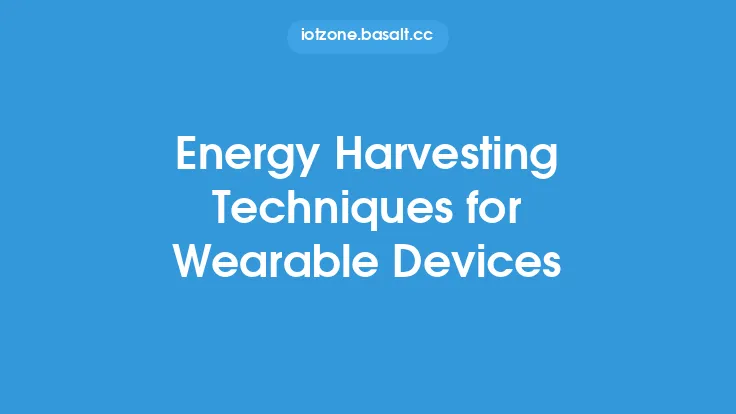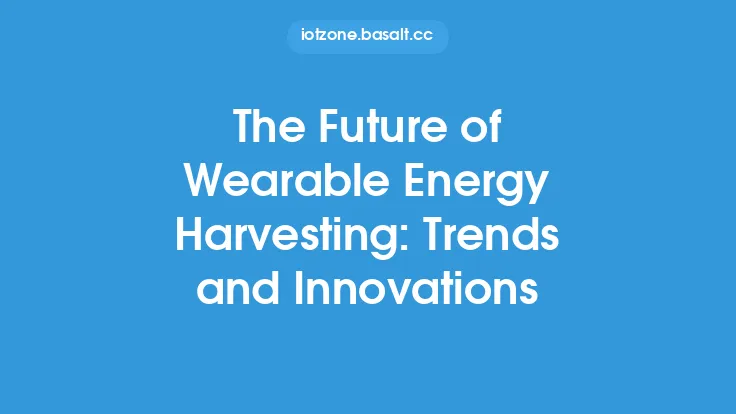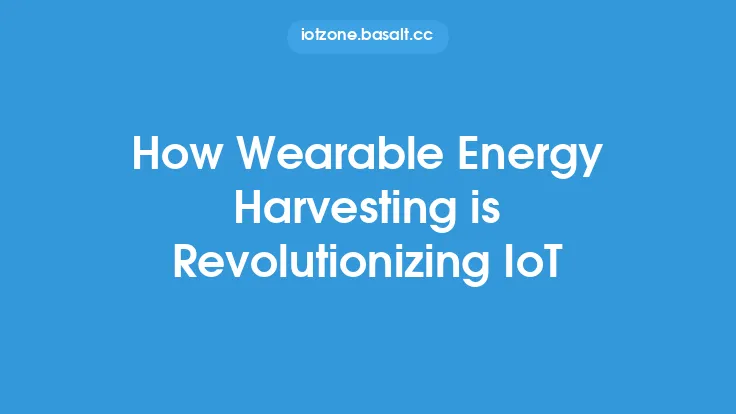The concept of wearable technology has been around for several decades, but it wasn't until the introduction of smartwatches and fitness trackers that the industry started to gain significant traction. Today, wearable devices are an integral part of our daily lives, from tracking our physical activity and vital signs to providing us with notifications and entertainment on the go. However, one of the major challenges facing the wearable technology industry is the limited battery life of these devices, which can be a significant hindrance to their widespread adoption. This is where sustainable wearable technology through energy harvesting comes into play, offering a promising solution to the power conundrum.
Introduction to Energy Harvesting
Energy harvesting refers to the process of capturing and converting ambient energy into electrical energy, which can then be used to power wearable devices. This technology has been around for several years and has been used in a variety of applications, including industrial sensors, medical devices, and consumer electronics. In the context of wearable technology, energy harvesting offers a sustainable and efficient way to power devices, reducing the need for batteries and minimizing electronic waste. There are several types of energy harvesting technologies, including solar, thermal, kinetic, and electromagnetic, each with its own strengths and weaknesses.
Types of Energy Harvesting Technologies
Solar energy harvesting is one of the most common types of energy harvesting technologies used in wearable devices. It involves the use of photovoltaic cells to convert sunlight into electrical energy. Solar energy harvesting is particularly useful for devices that are exposed to sunlight for extended periods, such as smartwatches and fitness trackers. Thermal energy harvesting, on the other hand, involves the use of thermoelectric materials to convert heat into electrical energy. This technology is particularly useful for devices that are in close proximity to the human body, such as smart clothing and wearable sensors. Kinetic energy harvesting involves the use of piezoelectric materials to convert mechanical energy into electrical energy. This technology is particularly useful for devices that are subject to mechanical stress, such as smart shoes and wearable sensors. Electromagnetic energy harvesting involves the use of coils and antennas to capture and convert electromagnetic radiation into electrical energy. This technology is particularly useful for devices that are in close proximity to electromagnetic sources, such as smartphones and tablets.
Energy Harvesting for Wearable Devices
Energy harvesting for wearable devices is a complex process that requires careful consideration of several factors, including the type of energy harvesting technology used, the power requirements of the device, and the user's environment. For example, a wearable device that is designed to be worn on the wrist may require a different type of energy harvesting technology than a device that is designed to be worn on the head. Additionally, the power requirements of the device will play a significant role in determining the type of energy harvesting technology used. Devices that require high power consumption, such as smartwatches and fitness trackers, may require more advanced energy harvesting technologies, such as solar or kinetic energy harvesting. On the other hand, devices that require low power consumption, such as wearable sensors and smart clothing, may be able to use simpler energy harvesting technologies, such as thermal or electromagnetic energy harvesting.
Design and Implementation of Energy Harvesting Systems
The design and implementation of energy harvesting systems for wearable devices require careful consideration of several factors, including the type of energy harvesting technology used, the power requirements of the device, and the user's environment. The first step in designing an energy harvesting system is to determine the power requirements of the device. This involves calculating the total power consumption of the device, including the power required for sensing, processing, and communication. The next step is to select the type of energy harvesting technology that is best suited for the device. This involves considering factors such as the availability of energy sources, the efficiency of the energy harvesting technology, and the cost and complexity of the system. Once the type of energy harvesting technology has been selected, the next step is to design and implement the energy harvesting system. This involves selecting the appropriate components, such as sensors, energy harvesting modules, and power management circuits, and integrating them into a single system.
Challenges and Limitations of Energy Harvesting
While energy harvesting offers a promising solution to the power conundrum in wearable technology, there are several challenges and limitations that need to be addressed. One of the major challenges is the limited efficiency of energy harvesting technologies, which can result in low power output and reduced device performance. Another challenge is the variability of energy sources, which can make it difficult to predict and manage power generation. Additionally, energy harvesting systems can be complex and expensive to design and implement, which can increase the cost and complexity of wearable devices. Furthermore, energy harvesting systems can also have a significant impact on the user's experience, particularly if the device is not able to generate enough power to support its functions.
Future Directions and Opportunities
Despite the challenges and limitations of energy harvesting, there are several future directions and opportunities that are worth exploring. One of the most promising areas of research is the development of new energy harvesting technologies, such as nanogenerators and bio-inspired energy harvesting systems. These technologies have the potential to significantly improve the efficiency and power output of energy harvesting systems, enabling the development of more sophisticated and powerful wearable devices. Another area of research is the development of advanced power management systems, which can optimize power generation and consumption in wearable devices. This can involve the use of sophisticated algorithms and machine learning techniques to predict and manage power generation, as well as the development of new power storage technologies, such as supercapacitors and batteries. Additionally, there is also a growing interest in the development of wearable devices that can harvest energy from multiple sources, such as solar, thermal, and kinetic energy. This can enable the development of devices that are more efficient, reliable, and sustainable, and can operate for extended periods without the need for battery replacement or recharging.
Conclusion
Sustainable wearable technology through energy harvesting offers a promising solution to the power conundrum in wearable devices. By capturing and converting ambient energy into electrical energy, energy harvesting technologies can reduce the need for batteries and minimize electronic waste. While there are several challenges and limitations that need to be addressed, the future directions and opportunities in energy harvesting are significant, and are likely to play a major role in shaping the future of wearable technology. As the wearable technology industry continues to evolve and grow, it is likely that energy harvesting will become an increasingly important aspect of device design and development, enabling the creation of more efficient, reliable, and sustainable devices that can operate for extended periods without the need for battery replacement or recharging.





